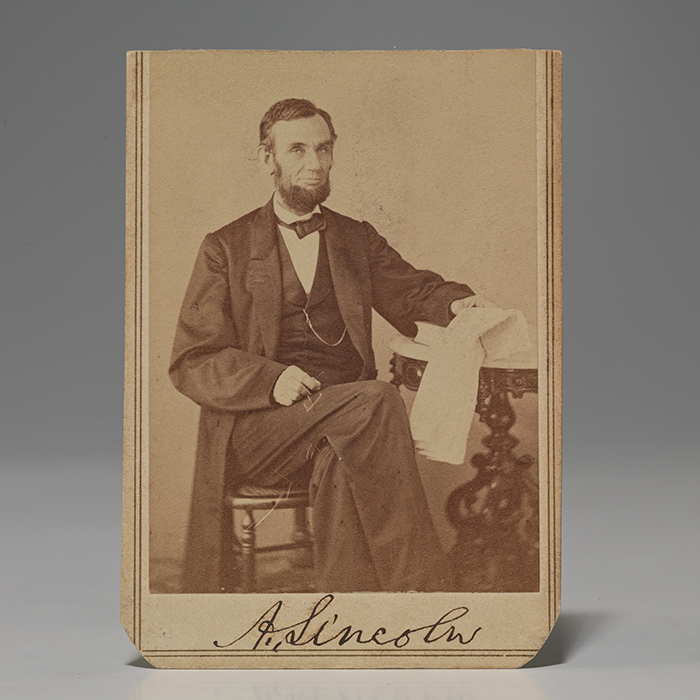
"IN LINCOLN'S FACE… AMERICAN CHARACTER": A GREAT RARITY—VINTAGE CARTE-DE-VISITE OF LINCOLN, SIGNED BY HIM AS PRESIDENT, TAKEN ON AUGUST 9, 1863, WITHIN WEEKS OF THE BATTLE OF GETTYSBURG
(LINCOLN, Abraham) (GARDNER, Alexander). Carte-de-visite photograph signed by Lincoln ("A. Lincoln") as President. (Photograph taken in Washington, DC, August 9, 1863). Vintage albumen print, 2-3/8 by 3 inches, mounted on 2-1/2 by 3-1/2 inch stiff card stock within double-ruled borders, signed in blank space below the image at lower edge. $110,000.
Exceedingly rare Alexander Gardner carte-de-visite portrait of Lincoln, boldly signed "A. Lincoln" below the image, one of only three signed examples of this image that we know of, showing him seated at a marble-topped table with his reading glasses in one hand and the partially folded pages of a newspaper in the other, this exceptionally rare portrait printed from Gardner's glass collodion negative, taken at his Washington studio on August 9, 1863.
After the Battle of Gettysburg, Lincoln was "buoyed by the thought that 'the rebel power is at last beginning to disintegrate" (Kearns Goodwin, 545). Lincoln spent many friendly hours with his private secretary John Hay, who was in many ways like a son to the President. "In his diary, Hay described a number of pleasant outings" that summer. Of particular note was one Sunday, on August 9, when "Hay accompanied the president to Gardner's photo studio at the corner of Seventh and D Streets," where Gardner took one of his very first photographs of Lincoln (Kearns Goodwin, 545) and six other images as well. Known for his iconic images of the Civil War, Gardner and his work are closely associated with that of Mathew Brady. On that day, in Gardner's studio, Lincoln sat at a "marble-topped table, reading glasses in one hand, holding partially folded sheets of a Washington newspaper; it seems a certainty that Gardner has posed Lincoln— an avid reader of the news— in the act of reading the Sunday newspapers. The sitting which produced this and six other images was on Sunday, August 9, 1863 and Lincoln's private secretary, John Hay, noted in his diary: 'I went down with the President to have his picture taken at Gardner's. He was in very good spirits" (quoted by Katz, Witness to an Era, 112). As was common during such lengthy and often arduous portrait sittings, the subject's expression, like Lincoln's, would be somber. "There are a number of reasons for this: In Lincoln's time, photographic exposures were so lengthy that if the subject did not remain motionless at a sitting and hold his facial expression while the camera was open, his photographic image would become blurred. Also, Lincoln, who loathed affectations, would have felt awkward holding a smile for several seconds… With the exception of one early daguerreotype, all the known photographic poses of Lincoln were made during the last eleven years of his life— between 1854, when he was 45 years old, and 1865. By a fortunate coincidence, these were the years of Lincoln's prominence… In Lincoln's face, as in the story of his life, every American can see something made of this country's toil… American character as it forged, and sought to define, itself" (Mellon, 9-14).
On the same day as this sitting, Lincoln also wrote to General Ulysses S. Grant, urging the recruitment of black soldiers: "Gen. [Lorenzo] Thomas has gone again to the Mississippi Valley, with the view of raising colored troops… I believe it is a resource which, if vigorously applied now, will soon close the contest. It works doubly, weakening the enemy and strengthening us" (Powell III:201).
Less than 140 known photographic views of Lincoln have survived, in the form of daguerreotypes, a few salt prints, tintypes, ambrotypes, stereographic cards and cartes-de-visite— the latter, 2-1/2 by 3-1/2 albumen prints such as this rare portrait, each "printed on albumen paper from glass collodion negatives… Many of the photographs have been desecrated or destroyed… The fugitive nature of the photographic chemicals themselves has caused many of the original albumen prints to fade… Of the 103 surviving poses known, or believed, to have originated as glass collodion negatives made for printing, there are only 24 for which an original, or suspected original negative can still be found. The remaining 78 poses survive only as original prints or as copies of lost originals." This carte-de-visite was created from the multiple-image stereographic glass collodion negative made by Alexander Gardner, in Washinton, DC, August 9, 1863. The original negative has been lost (Mellon, 9-14, 129). Contains Gardner's Washington D.C. studio inkstamp on card verso; card backing with rounded lower corners, trimmed at the upper edge without affecting image. We know of only two other surviving signed examples of this image.
Image crisp, signature bold and dark. A superb signed carte-de-visite, exceedingly rare and desirable.